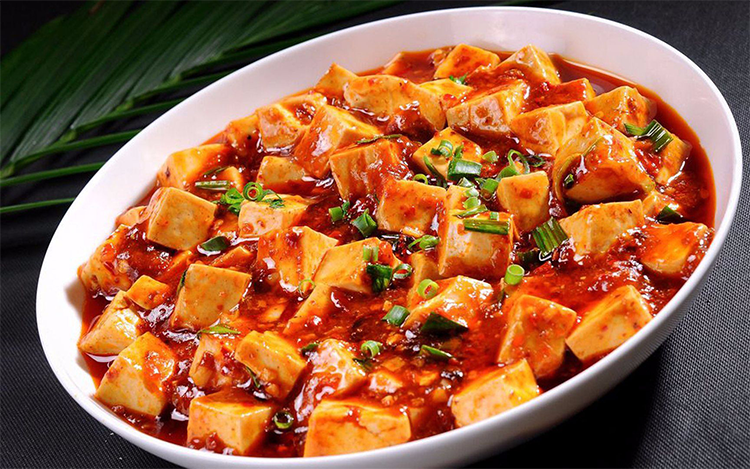Sichuan Cuisine’s Soul: The Spicy Allure of Mapo Tofu
Imagine a steaming bowl of white rice topped with cubes of silky tofu bathed in a bright red, chili-infused sauce—fragrant with Sichuan pepper and savory Pixian Doubanjiang. This is Mapo Tofu, a mouth-tingling and aromatic dish that perfectly embodies the bold spirit of Sichuan cuisine. More than just a spicy favorite, it’s a window into Chengdu’s dynamic food culture and the heart of southwest China’s gastronomy.
1. History: From Street Stall to Global Table
Mapo Tofu originated in Chengdu during the Qing Dynasty (1862–1875). It was created by a woman named Chen Mapo (“Pockmarked Mrs. Chen”), who sold her delicious tofu near Wanfu Bridge. Affordable and flavorful, her dish quickly gained fame among local workers. What began as humble street food evolved into a Sichuan classic, and with China’s global influence in the late 20th century, Mapo Tofu found its way to restaurants across Tokyo, London, and New York.
2. Cultural Significance: The Sichuan Spirit Behind the Heat
Mapo Tofu represents more than flavor—it reflects the Sichuan people’s hearty and practical approach to life. In this humid region, chili and peppercorns are essential for warming the body and driving out dampness. The “mala” (numbing and spicy) flavor captures the essence of Sichuan cuisine. The dish’s contrast—soft tofu paired with bold, oily sauce and minced meat—symbolizes local resilience and creativity. Whether served at home or in fine restaurants, it’s a comfort food that celebrates local pride.

3. Ingredients: Simple Items, Distinctive Flavors
Authentic Mapo Tofu depends on key ingredients: soft silken tofu, finely minced beef or pork, rich Pixian Doubanjiang (fermented broad bean and chili paste), and fragrant Sichuan peppercorns—preferably from Hanyuan County. Garlic, scallions, fermented black beans (Douchi), chili powder, soy sauce, and broth enhance the layers of flavor. The freshness of tofu and peppercorns defines the dish’s quality and aroma.
4. Preparation: The Art of Balancing Heat and Texture
A well-made Mapo Tofu follows a precise rhythm: blanch tofu briefly, brown minced meat for texture, and stir-fry Doubanjiang and Douchi until the red oil surfaces. Add broth and simmer the tofu gently, allowing it to absorb flavor. Finally, thicken the sauce and sprinkle freshly ground Sichuan pepper and scallions. The ideal Mapo Tofu looks “alive”—bubbling, glossy, and fragrant when served.
Home tip: Use soft tofu and handle it gently. A pinch of sugar can balance the chili, and fresh-ground peppercorns bring out the best aroma.

5. Flavor Profile: The Eightfold Sensation
Mapo Tofu is known for its eight distinct sensations: numbing, spicy, hot, fragrant, crisp, tender, fresh, and lively. The Sichuan pepper’s numbing tingle blends with chili heat, while tofu offers a silky counterbalance to the savory minced meat. Every bite is bold, dynamic, and satisfying—especially when paired with steamed rice or a cold beer.
6. Where to Try It in Chengdu and Beyond
For the most authentic Mapo Tofu, visit Chengdu’s local eateries and traditional markets, where chefs still cook over high flames. Beyond China, look for restaurants that use Pixian Doubanjiang and Hanyuan peppercorns for a genuine taste. Don’t hesitate to ask the chef how they prepare their version—it’s often a mark of authenticity.
7. Dietary Notes and Variations
Vegetarian diners can replace minced meat with mushrooms or tofu crumbles while keeping the spicy Doubanjiang base. Adjusting the chili and peppercorn levels creates a milder but still flavorful version, perfect for those sensitive to spice.

8. Conclusion: A Taste of Sichuan’s Culinary Soul
Mapo Tofu is a simple dish with deep meaning—soft tofu, savory sauce, and numbing spice coming together in perfect harmony. For travelers to Chengdu or food lovers exploring Sichuan cuisine, tasting or making Mapo Tofu is an unforgettable culinary experience and a direct link to the fiery heart of China’s most flavorful region.


